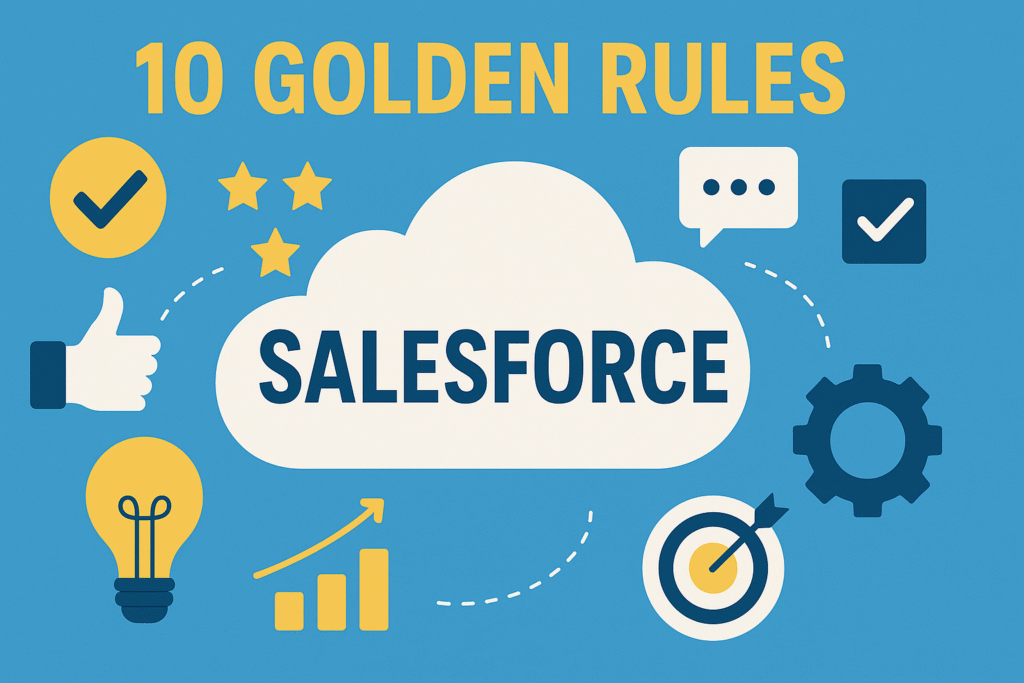10 Golden Rules for a Successful Salesforce Implementation

Introduction: Salesforce Implementation
Implemented Salesforce can be a game-changer for any organization. When done properly, it increases productivity, trims performance, and provides efficient insights into consumers, sales, and business growth. However, the implementation of Salesforce is not just about using technology—it is about changing processes, people, and cultures to align with professional goals. Below are ten gold rules to ensure a successful implementation of sales for a successful implementation journey.
Table of Contents
1. Define Clear Business Objectives
Each successful sales force project begins with a clear understanding of business goals. Before diving into configuration or customization, identify what your organization wants to achieve—whether it improves lead conversion rates, increases customer service, or gains better visibility in sales displays. Well-defined objectives act as the foundation of design decisions, user adoption strategies, and long-term success measurements.
Main Tip: Align the capabilities of the sales for your business with KPI and create a roadmap that reflects both urgent needs and future growth.
2. Get Executive Sponsorship and Stakeholder Buy-In
Leadership support is important for the success of the implementation of any Salesforce. Without strong working sponsorship, projects can lose direction, funds, or priorities. Executive sponsors act as champions who communicate the importance of adopting Salesforce, encourage users’ participation, and ensure institutional alignment.
Major Tip: Identify the main stakeholders as soon as possible to ensure that sales, marketing, and service leaders—and platforms—meet everyone’s expectations in the planning, testing, and response cycle.
3. Choose the Right Implementation Partner
The choice of a trusted sales force implementation partner can make or break your project. The right partner brings technical skills, the best methods, and experience in all industries to help you avoid common difficulties. They also help the salesforce to suit your organization’s unique functioning rather than using a one-for-one-way-to-one approach.
Main Tip: Search for a Salesforce-honored consultant partner with proven track records, solid customer reviews, and strong support after implementation.
4. Focus on User Adoption from Day One
Even the most technically advanced sales force system will fail if the end users do not accept it. Resistance to change is natural, especially when employees are comfortable with existing systems. Initial user involvement helps to ensure easy adoption.
Main Tip: Include users in the workshops, collect their input on workflow, and provide hands-on training. Create a sales force champion in sections to promote connections and share success stories.
5. Keep Customization Simple
Salesforce provides infinite customization possibilities—too much customization can complicate maintenance and improvements. Can slow over-engineering operations on the platform and make scaling difficult in the future. Instead, focus on the best out-of-the-box features first.
Main Tip: Use configuration tools such as flows, Lightning app builders, and reports before turning to the Apex code. Always document customization to facilitate troubleshooting and enhancement later.
6. Data Quality Is Non-Negotiable
Your sales force system is as good as it has data. Poor quality information leads to inaccurate reports, incorrect decisions, and frustrated users. A strong data governance strategy ensures that your CRM remains the only source of truth.
Main Tip: Clear and validate the information before migration. Define clear data entry standards, duplicate management rules, and regular audits to maintain integrity after implementation.
7. Plan for Integration Early
Salesforce rarely works differently. Most organizations need to integrate Salesforce with other business systems such as ERP, marketing automation, or customer support tools. Initial planning coordination ensures the flow of simple information and reduces the re-function of the projection.
Main Tip: Use tools such as MuleSoft, Salesforce, or API to create a relentless coordination. Create a compilation with regard to measurement and security, especially when handling sensitive customer data.
8. Prioritize Security and Compliance
Salesforce offers strong security features, but proper configuration is important. Roles, profiles, permit sets, and sharing rules should be carefully prepared to control the entrance by maintaining the efficiency of the operation.
Main Tip: Salesforce Security Best Methods-Apply Davi-Peround Authentication, limit the visibility of information for the required users, and regularly audit system access. Be sure to comply with the GDPR, HIPAA, or local data privacy laws.
9. Embrace Continuous Improvement
Salesforce is not a “set it and forget it” system. As your business develops, you should have a sales force setup. Regular review of processes to enhance efficiency and connection, collect user feedback, and take advantage of new Salesforce features.
Main Tip: Establish the Salesforce Center of Excellence (COE) that manages improvements, evaluates new publications, and operates ongoing innovation in sections.
10. Measure, Monitor, and Celebrate Success
The final rule of successful sales for implementation is to monitor the function and celebrate the landmarks. Define measurable KPIs—amend the lead-to-opportunity conversion rate to evaluate success or reduce the time of case resolution. Identifying achievements helps maintain inspiration and strengthens the value of the salesforce for the organization.
Main Tip: Use Salesforce Dashboards and Reports to monitor progress and regularly share insights with interest holders. Celebrate both small wins and major landmarks to promote long-term enthusiasm.
Key Takeaway:
Implementation of Salesforce is more than just a technical deployment—it is a strategic change journey. Compliance with these ten golden rules ensures that your organization not only successfully adopts Salesforce but also provides measured business results. You can unlock the full capacity of the Salesforce and turn it into a powerful engine for development by determining clear goals, maintaining the quality of information, promoting the user to adopt, and continuously improving the processes. When done properly, Salesforce is not only the CRM system but also becomes the heartbeat of your digital change.

